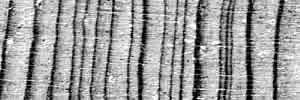Tree-ring dating, often referred to as dendrochronology is one of two main methods of dating. A dendrochronologist is a scientist that specializes in tree rings in order to form conclusions about the natural world and human behavior. The technique was developed by A.E. Douglass, an American astronomer in the early decades of the last century (Renfrew and Bahn 2018, 108-140). Now used in modern archeology along with radiocarbon dating, Douglass pioneering technique cemented a ground foundation for dating artifacts found today.
In order to perform the process of tree-ring dating, dendrochronologists first measure and plot tree rings and produce a diagram that indicates the thickness of successive rings in an individual tree (Renfrew and Bahn 2018, 108-140). After this, it’s all about figuring out the age of each tree and organizing them by chronological order. This chronological sequence of timber can present a story of the past till now.

Figure 1. Dendrochronologists analyze sequences of tree timber in order to match its pattern rings to older timbers. This will give a chronological idea of the area/site.
The technique is now a crucial tool for archaeologists, who can use tree ring chronologies for more than 4,000 sites on six continents to trace up to 13,000 years of history. Although trees add a new ring every growing season, trees don’t develop their trunks consistently. Trunk growth is closely linked to climate conditions. Under ideal conditions, trees grow quickly, leaving wide annual rings behind. During droughts, unseasonable cold, and other unusual conditions, growth slows, leaving behind narrow rings (Blakemore 2019). With these findings, dendrochronologists are able to determine the age of the tree and the type of condition the tree lived under. Tree rings can tell us so much!

Figure 2. The conifer wood displays much variation in its rings. There is a contrast in color and width size due to the different variety of environmental conditions the tree was exposed to.
However, like previously mentioned, unfavorable conditions can leave the tree-ring method to be last in the pecking order. The big reason is being that the trees must be under ideal conditions. That being said, dendrochronology can’t be used as a worldwide technique given that climate is different and constantly changing. As a result, tree-ring dating “applies only to trees in regions outside the tropics where pronounced differences between the seasons produce clearly defined annual rings” (Renfrew and Bahn 2018, 108-140). Taking it a step further, the method can’t be used if the tree ring is from wood that’s been used by humans, have allowed a sequence that’s in the present, or if the sample is too complex to match with other samples. Nonetheless, dendrochronology will continue to be a pivotal tool for future generations, especially as warmer climates become more and more prevalent.
Further Readings:
The History of the World is Written in Tree Rings
References:
Blakemore, Erin. 2019. “How are tree rings used to help date an archeological site?” National Geographic. https://www.nationalgeographic.com/culture/article/how-tree-rings-date-archaeological-site
Renfrew, Colin, and Paul Bahn. 2018. Archaeology Essentials: Theories, Methods, and Practice. Fourth edition. Thames & Hudson. 108-140.

How does tree ring dating vary by location (in the eastern vs the southwestern United States, for example)? How does this affect our ability to use dendrochronology to interpret archaeological sites?
Tree ring dating varies by location depending on the climate the environment is accustomed to. For example, tree ring dating perform in Eastern United States may not be as effective as southwestern United States. Tree ring dating performs best under extreme climates, like super hot or cold weather. Under these conditions, multiple rings can be produced. This affects our ability to use dendrochronology to interpret archeological sites because in some sites, there may not be any rings at all thus making the method ineffective.